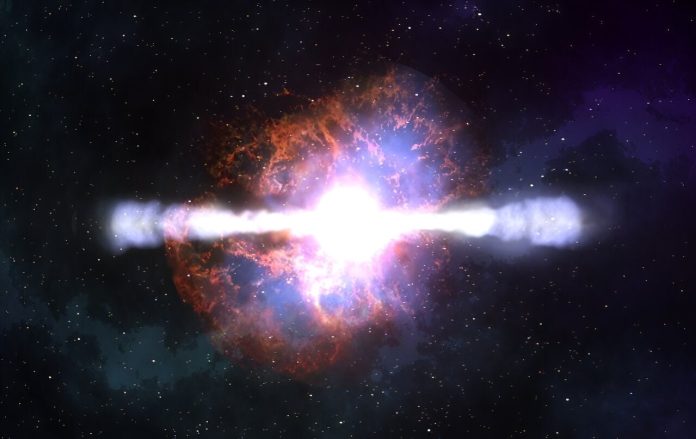
When a massive star explodes as a supernova, it does more than release an extraordinary amount of energy.
Supernovae explosions are responsible for creating some of the heavy elements, including iron, which is blasted out into space by the explosion.
On Earth, there are two accumulations of the iron isotope 60Fe in sea-floor sediments that scientists trace back to about 2 or 3 million years ago and to about 5 to 6 million years ago.
The explosions that created the iron also dosed Earth with cosmic radiation.
In new research submitted to The Astrophysical Journal Letters, scientists examine how much energy reached Earth from these explosions and how that radiation may have affected life on Earth.
The paper is titled “Life in the Bubble: How a nearby supernova left ephemeral footprints on the cosmic-ray spectrum and indelible imprints on life,” and it is available on the arXiv preprint server.
The lead author is Caitlyn Nojiri from UC Santa Cruz.
“Life on Earth is constantly evolving under continuous exposure to ionizing radiation from both terrestrial and cosmic origin,” the authors write. Terrestrial radiation slowly decreases over billions of years.
But not cosmic radiation. The amount of cosmic radiation that Earth is exposed to varies as our solar system moves through the galaxy.
“Nearby supernova (SN) activity has the potential to raise the radiation levels at the surface of the Earth by several orders of magnitude, which is expected to have a profound impact on the evolution of life,” they write.
The authors explain that the 2-million-year-old accumulation is directly from a supernova explosion, and the older accumulation is from when Earth passed through a bubble.
The bubble in the study’s title comes from a particular type of star called OB stars. OB stars are massive, hot, and short-lived stars that usually form in groups. These stars emit powerful outflowing winds that create “bubbles” of hot gas in the interstellar medium.
Our solar system is inside one of these bubbles, called the Local Bubble, which is almost 1,000 light-years wide and was created several million years ago.
The Earth entered the Local Bubble about 5 or 6 million years ago, which explains the older 60Fe accumulation. According to the authors, the younger 60Fe accumulation from two or 3 million years ago is directly from a supernova.
“It is likely that the 60Fe peak at about 2–3 Myr originated from a supernova occurring in the Upper Centaurus Lupus association in Scorpius Centaurus (~140 pc) or the Tucana Horologium association (~70 pc).
Whereas the ~ 5–6 Myr peak is likely attributed to the solar system’s entrance into the bubble,” the authors write.
The Local Bubble is not a quiet place. It took multiple supernovae to create it. The authors write that it took 15 SN explosions over the last 15 million years to create the LB. “We know from the reconstruction of the LB history that at least nine SN exploded during the past 6 Myrs,” they write.
The researchers took all the data and calculated the amount of radiation from multiple SNe in the LB. “It is not clear what the biological effects of such radiation doses would be,” they write, but they do discuss some possibilities.
The radiation dosage may have been strong enough to create double-strand breaks in DNA. This is severe damage and can lead to chromosomal changes and even cell death. But there are other effects in terms of the development of life on Earth.
“Double-strand breaks in DNA can potentially lead to mutations and a jump in the diversification of species,” the researchers write. A 2024 paper showed that “the rate of virus diversification in the African Tanganyika lake accelerated 2–3 Myr ago.” Could this be connected to SN radiation?
“It would be appealing to better understand whether this can be attributed to the increase in cosmic-radiation dose we predict to have taking place during that period,” the authors tease.
The SN radiation wasn’t powerful enough to trigger an extinction. But it could’ve been powerful enough to trigger more mutations, which could lead to more species diversification.
Radiation is always part of the environment. It rises and falls as events unfold and as Earth moves through the galaxy. Somehow, it must be part of the equation that created the diversity of life on our planet.
“It is, therefore, certain that cosmic radiation is a key environmental factor when assessing the viability and evolution of life on Earth, and the key question pertains to the threshold for radiation to be a favorable or harmful trigger when considering the evolution of species,” the authors write in their conclusion.
Unfortunately, we don’t clearly understand exactly how radiation affects biology, what thresholds might be in place, and how they might change over time. “The exact threshold can only be established with a clear understanding of the biological effects of cosmic radiation (especially muons that dominate at ground level), which remains highly unexplored,” Nojiri and her co-authors write.
The study shows that, whether we can see it in everyday life or not, or even if we’re aware of it or not, our space environment exerts a powerful force on Earth’s life. SN radiation could’ve influenced the mutation rate at critical times during Earth’s history, helping shape evolution.
Without supernova explosions, life on Earth could look very different. Many things had to go just right for us to be here. Maybe in the distant past, supernova explosions played a role in the evolutionary chain that leads to us.



